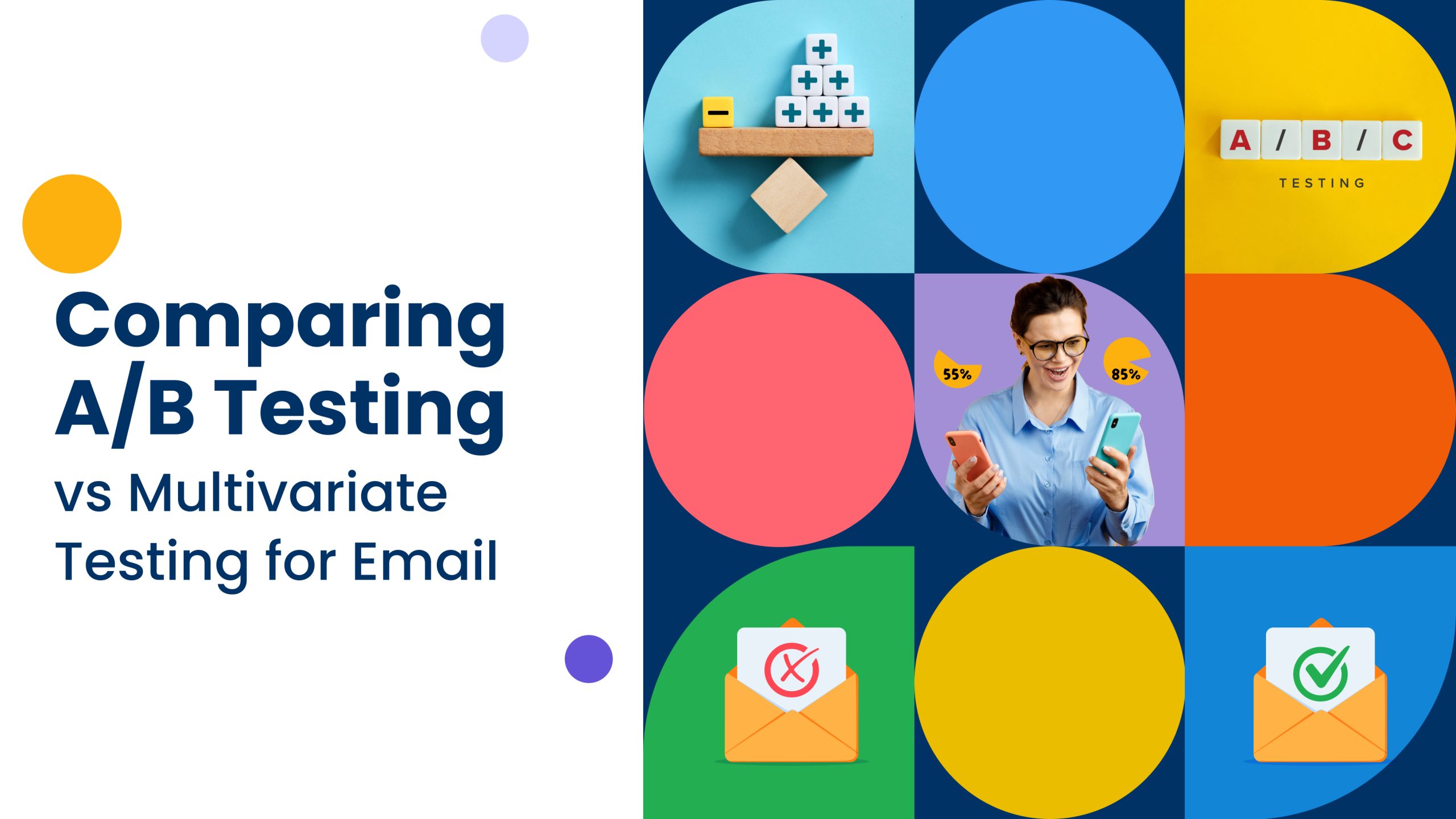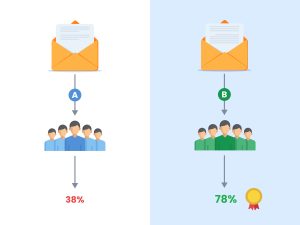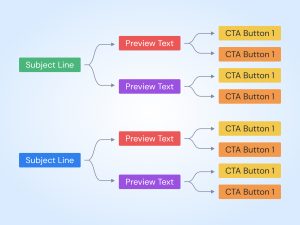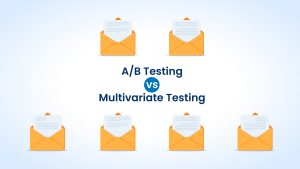Optimizing your email marketing strategy is crucial to increase opens, clicks, and, ultimately, sales.
That’s where A/B testing and multivariate testing come in —powerful tools for finding what makes your audience tick.
A/B testing lets you compare two versions of an email element, like a subject line or call-to-action button.
Multivariate testing takes things a step further, allowing you to test multiple elements at once.
This can uncover the ideal combination for maximum impact.
So, the big question is: A/B or multivariate testing – which one will reign supreme in your email marketing strategy?
Let’s dive in and find the perfect fit for your next campaign!
What is A/B Testing?
Definition and Basics of A/B Testing
A/B testing is a method that compares two versions of something to see which one performs better. It involves creating two slightly different versions of your email and sending them to separate groups within your mailing list. By analyzing which version gets more opens, clicks, or conversions, you can identify the “winning” format for your audience.
Here’s the key: A/B testing focuses on changing only one variable at a time. This could be the subject line, the call to action (CTA) button, the email layout, or even the send time. This isolation allows you to pinpoint exactly what’s influencing the results and make data-driven decisions for future emails.
Here’s the A/B testing process for emails in a nutshell:
- Choose an element to test: This could be your subject line, CTA button, email layout, or even the send time.
- Create two variations: Modify the chosen element in one version of your email while keeping everything else identical.
- Split your audience: Divide your email list into two random groups. Send one version to one group and the other version to the other group.
- Track and Analyze Results: Monitor which version gets a better response based on your chosen metric (opens, clicks, conversions).
The Benefits of A/B Testing for Emails
A/B testing is a secret weapon for email marketers. Here’s how it can improve your campaigns:
- Identify Best Performers: Unsure which subject line will grab attention? A/B testing helps you pinpoint the email elements that resonate most with your audience.
- Boost Engagement Rates: By identifying high-performing elements, you can create emails that subscribers are more likely to open and click on. This can lead to a more engaged audience.
- Optimize for Conversions: A/B testing allows you to refine your email CTAs (calls to action) and overall message flow. This can ultimately drive more subscribers toward your desired outcome.
Putting A/B Testing into Practice: Common Examples
Let’s see A/B testing in action with some real-world examples you can try:
- Test a short subject line against a lengthier one with more details.
- See if a bright red CTA button gets more clicks than a subtle blue one.
- A/B test including a subscriber’s name in the email greeting compared to a generic salutation.
- Experiment with sending times and frequency to see what resonates better with your audience.
- Test using different types of images or graphics in your email.
These are just a few examples, the possibilities are truly endless! A/B testing empowers you to continuously improve your email marketing, ensuring your messages hit the mark with every send.
What is Multivariate Testing?
Unlocking Synergies: Multivariate Testing Explained
Imagine testing not just two variations, but a whole orchestra of possibilities! That’s the power of multivariate testing in email marketing.
It goes beyond A/B testing by allowing you to experiment with multiple variables simultaneously.
It’s a method that tests various combinations of different elements within your email to discover the absolute best-performing version.
Let’s say you want to test your subject line, preview text, and CTA button. Multivariate testing creates multiple email variations that combine different versions of each element. Imagine Subject Line A paired with Preview Text 2 and CTA Button 1, or Subject Line B with Preview Text 1 and CTA Button 3. Each subscriber receives one of these unique combinations, allowing you to see which combination resonates most.
Advantages of Multivariate Testing for Emails
While A/B testing is fantastic, multivariate testing takes things a step further:
- Identify Optimal Combinations: Multivariate testing uncovers the winning combination of all the tested elements working together.
- Deeper Insights: By analyzing how different elements interact, you gain a richer understanding of your audience’s preferences. You might discover that a specific subject line works best when paired with a particular CTA button color.
- Boost Engagement and Conversions: With the knowledge of the optimal combination, you can craft emails that are more likely to lead to conversions.
Multivariate Testing in Action: Examples
Here are a couple of ideas to see how multivariate testing translates into real-world email marketing:
- Test different combinations of subject lines, preview text, and CTA button variations to see which combination gets the most clicks.
- Test different images alongside variations in email body copy to see which combination leads to the most engagement.
Remember, while multivariate testing offers incredible insights, it usually requires a larger subscriber base to ensure statistically significant results. However, if you have the audience size, it can be a powerful tool for your email marketing efforts.
A/B Testing vs Multivariate Testing: Making the Choice
Now it’s time to decide which method is the right tool for the job. Here’s a table to help you compare the key differences:
| Feature | A/B Testing | Multivariate Testing |
| Complexity | Simpler – Tests one variable at a time | More complex – Tests multiple variables and their interactions |
| Time Consumption | Faster – Requires less time to set up and analyze results | Slower – Requires more time to create variations and analyze data |
| Statistical Significance | Easier to achieve statistical significance with smaller sample sizes | Harder to achieve statistical significance – requires a larger audience |
| Resource Allocation | Lower – Requires fewer email variations and a smaller sample size | Higher – Requires creating multiple variations and a larger sample size |
Here’s a quick breakdown to help you decide:
Choose A/B testing if: You’re new to email marketing optimization and your audience is relatively small. You also want to quickly test specific elements like subject lines or CTAs.
Choose multivariate testing if: You have a large subscriber base and want to explore the interactions between elements. You also aim to identify the absolute best-performing email combination.
Remember, don’t be afraid to experiment and see what works best for your email marketing strategy!
Conclusion
By incorporating these testing methods into your email marketing strategy, you can transform your emails from good to great.
Ready to implement your perfect email marketing strategy?
Business Marketing Engine is here to help! Our expert team can guide you through the A/B and multivariate testing process to achieve your marketing goals.
Contact us today for a free consultation! Let’s work together to turn your email marketing into a lead-generation machine.






